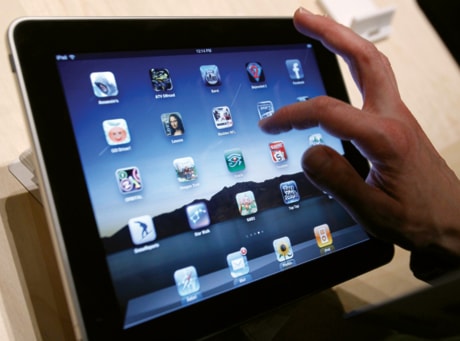TORONTO — Consumers who aren’t quite sure whether they need or can afford one of Apple’s iPad tablet computers may not have to wait long for cheaper alternatives to hit the market.
About two months after its U.S. release, the iPad finally comes to Canada on Friday with a range of models priced between $549 and $879.
The reviews have been almost unanimously positive with only a few relatively minor caveats.
Although Apple CEO Steve Jobs has suggested the iPad will be a netbook killer, eliminating the need for the small laptops, many users have said the tablet is not quite a replacement for a real computer. There have also been quibbles about the fact that the iPad’s web browser doesn’t handle video and animation-rich websites that use the Flash plug-in. It also lacks a webcam and doesn’t yet allow multitasking.
But it is an undeniably impressive tech toy and owns the tablet market. For now.
“I have a feeling (the tablet market) is probably going to evolve very quickly,” said Emily Taylor, an analyst with IDC Canada.
“I anticipate the offerings will be coming out pretty fast and furious for the remainder of 2010 and into 2011.”
It’s unlikely that the iPad will look like yesterday’s technology when other high-profile tablets hit the market. But Michael Gartenberg, a partner with the research firm Altimeter Group, said it’s fair to assume some of the rivals will at least give Apple a run for its money.
Waiting for the next big thing is tricky and could leave a consumer holding off on a purchase forever, Gartenberg said. But if shoppers are on the fence about buying a tablet, it wouldn’t hurt to hold off a bit and see what’s coming around the corner.
“Now that the market has clearly been validated no one is going to cede it to Apple. We’re going to see a lot of competition in this space,” said Gartenberg, who predicted other tablets will be announced soon.
“But the iPad is built upon an ecosystem including things like iTunes, it’s built on 10 years of consumers being educated about Apple products and how they work, so challengers are going to have to do their homework and really come up with a compelling product.”
Dell just announced it’s launching a smartphone-tablet hybrid, called the Streak, in the U.K. in early June and in the U.S. sometime in the summer. It has a smaller screen — 12.7 centimetres versus the iPad’s 24.6 centimetre screen — and runs on Google’s Android operating system. It does a few things the iPad doesn’t: it makes and receives phone calls, has a video camera, and its web browser can load Flash.
But Gartenberg is skeptical about the Streak posing a challenge to the iPad.
“I think (that) is a problematic size — it’s too big for your pocket and too big to really use as a phone. Since it’s going in your bag you might as well give it a big screen,” he said.
One of the most important factors, the price, has not yet been revealed by Dell.
U.S. company Verizon Wireless told the Wall Street Journal it is working with Google on a tablet to compete against the iPad, and rumours have circulated online about efforts by HP, Microsoft and Research In Motion to launch their own tablets.
The blog Boy Genius Report, which has built a reputation for obtaining accurate leaks of new products, recently reported a BlackBerry “companion” tablet is in the works. The 22.6-centimetre device would connect wirelessly to a BlackBerry to get Internet access, which would keep the tablet’s cost down.
The non-profit organization One Laptop Per Child has even announced that it is switching its focus to producing tablets, in the hopes of putting them in the hands of children in poor countries. The group thinks it can build a tablet with one or two video cameras, a Wi-Fi Internet connection, and the ability to play high definition video for less than US$100.
Ross Rubin, executive director of industry analysis for the NPD Group, said a category of low-cost tablets is already emerging and will flood the market before long.
Just as many consumers were happy to buy a no-frills MP3 player instead of a more-expensive iPod, the budget tablets will try to fill that niche by forgoing a few extra features and putting less emphasis on design aesthetics.
In June, Archos will start selling a 17.8 centimetre tablet for just US$199 and Pandigital, best known for producing digital picture frames, is preparing to release a 17.8 centimetre colour ebook reader for US$199, which will also be able to browse the web and play videos and music.
“None of these devices have yet seen the broad retail availability and marketing push behind them that Apple has created, but the iPad is certainly demonstrating the use case for this kind of device,” said Rubin.
By Christmas, the tablet market should have several major contenders, he said.
Gartenberg predicted there may be a limited market for the lower-priced devices and most consumers will probably want the better tablets.
And those manufacturers that want to challenge Apple will have to outdo the iPad if they want to get buyers’ attention, he added.
“Certainly there’s no room in the market for a lesser product, the iPad has set what the benchmark is and (manufacturers) now have to either meet that or exceed that if they’re going to succeed.”
